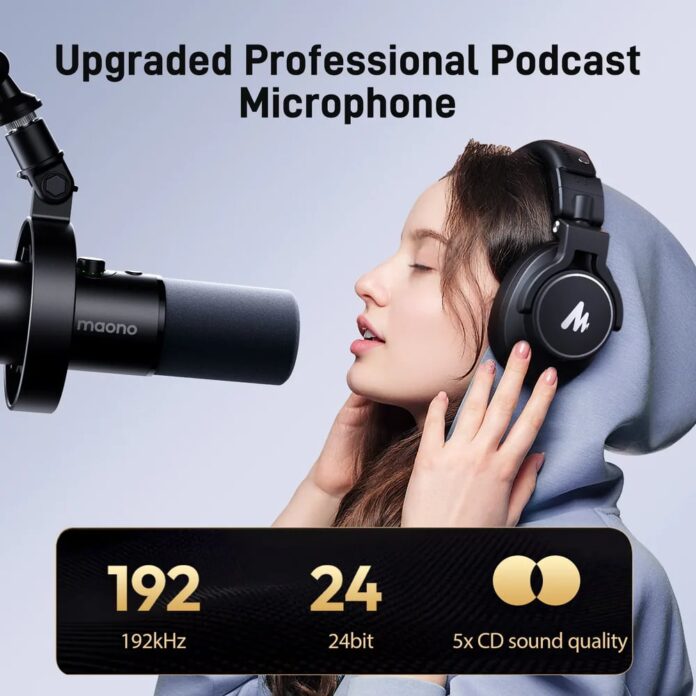If you’re using a bad mic, your podcasts won’t do well. It’ll record every little sound, drown out your voice, and make it harder to hold the audience’s attention. Meanwhile, a good mic cleans up the sound, makes your voice stand out further, and keeps your discussions flowing smoothly.
Let’s get started with the guide right away.
1. How the Mic Picks Up Sound (Polar Pattern)
Microphones pick up sound in different ways. Some focus on your voice, while others grab everything around them.
- A cardioid mic picks up sound from the front and blocks most noise from the sides and back. This keeps your voice clear and cuts out background noise.
- Supercardioid and hypercardioid mics focus even more on the front but can pick up some sound from behind. You’ll need to place them carefully.
- Omnidirectional mics grab sound from all directions. Good for group recordings, but not great if you want to block out room noise.
For solo podcasting, cardioid is the safest bet. It keeps your voice front and center while reducing unwanted noise. A good example of a mic that can do that is the Maono PD300X.
2. Dynamic vs. Condenser Mics
Microphones work in two main ways: dynamic and condenser.
- Dynamic mics focus on your voice and block background noise. They keep distractions, like chatter or distant footsteps, out of your recording.
- Condenser mics deliver detailed, natural sound but also capture every little thing, like your chair squeaking or distant traffic.
In a noisy room, a dynamic mic helps block out distractions. But if you’re in a quiet space and need more depth, a condenser mic is a better fit.
3. How the Mic Handles Your Voice (Frequency Response)
Frequency response changes how your voice comes across. A mic with a full hearing range- such as 20 Hz to 20 kHz- will pick up both low and high sounds, giving your voice more depth and clarity.
- A flat response means the mic picks up your voice as it is, with no changes. This works well when you want your voice to sound natural, like in interviews.
- Mid and high frequencies can make your voice stand out more. This helps with clarity, especially in noisy places or for podcasts. Just don’t boost too much, or your voice may sound unnatural.
For podcasting, you want a mic that keeps your voice full and natural. If a mic slightly boosts the midrange, it helps your voice stand out without sounding fake.
4. Mic Noise
Every mic makes a tiny bit of noise on its own. If it’s too much, it adds hiss to your recording.
- Self-noise is the noise a mic makes when you’re silent. With lower self-noise, you’ll get better sound and less interference from outside noises.
- SNR (Signal-to-Noise Ratio) is how your voice comes through compared to the background noise. A high SNR means clearer audio with less noise in the mix.
A mic with low self-noise and high SNR will give you a clean, crisp sound without extra fuzz.
5. USB vs. XLR: How the Mic Connects
Mics connect to your setup in two ways: USB or XLR.
- USB: Using USB mics is super simple. You just connect them to your computer or device, and you can begin recording instantly without having to tweak anything.
- XLR: You’ll need an audio interface or mixer to use these mics. But the upgrade is worth it, you get better sound and more control over the details like tone and volume. If you’re setting up a professional studio, you can get these.
6. Durability: Will It Last?
Podcasting mics get used a lot, so they need to last. A metal body holds up better than plastic. A shock mount helps keep vibrations from messing with your sound. If you’re moving your mic around often, durability matters.
7. How Much to Spend
Mics come in different price ranges. Paying more usually means better sound and build quality, but you don’t need to go overboard.
- Budget ($50–$150): These mics are decent but lack clarity and depth. They’ll work for basic recordings but won’t give you the best sound.
- Mid-range ($150–$500): You get ca learer, more balanced sound with good noise control.
- High-end ($500+): These mics deliver professional-level sound with incredible detail and minimal noise. They’re perfect for serious podcasting or studio work.
Final Thoughts
If you’re just starting, the Maono PD300X is a decent choice. It has USB and XLR options, so it’ll work with pretty much any setup. The 192kHz/24-bit sampling rate makes any sounds clear. The Maono Link software lets you adjust things like EQ and noise control without any headaches. Plus, its five-layer noise reduction helps cut out unwanted background noise.
Whatever you pick, just keep durability and budget in mind to make sure you get a mic that works for you without overspending.



